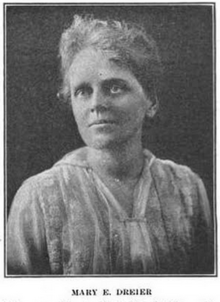Mary Dreier
Mary Elisabeth Dreier (born September 26, 1875 in Brooklyn , New York ; died August 15, 1963 ) was an American trade unionist and suffragette.
Life
Mary Dreier's father Theodor Dreier had emigrated from Germany after the revolution in 1848 , he worked as a merchant for a middle-class existence and in 1864 brought Dorothea Dreier, a distant cousin, from Bremen to join him . They had a son and four daughters. Dorothea Dreier and Katherine Dreier became painters, Mary Dreier, like Margaret Dreier, was involved in social policy and the women's movement. The children of the threesome received private tuition, especially in the arts, but the daughters did not attend college. Dreier later attended courses at the first educational institution for social workers, the New York School of Applied Philanthropy, opened in 1898 .
Like her sister Margret, Mary Dreier became a member of the New York Women's Trade Union League (NYWTUL), founded in 1903, an association of workers and women from the upper middle class who wanted to become active in social reform. Its aim was to educate the bourgeois public about working and living conditions and to bring about legal changes. Dreier became president of the association in 1906 and was executive president from 1914 to 1935. At the age of 75, she resigned from these honorary posts in 1950. In 1905 she moved in with the sociologist and social reformer Frances Kellor , the relationship ended with Kellor's death in 1952.
In 1909, Dreier's organization supported the New York textile workers' strike. She supported the women's suffrage movement and was a member of the Progressive Party . During Franklin D. Roosevelt's presidency , she supported his New Deal policy . In 1948 she promoted the presidential candidate of the progressives Henry A. Wallace . In the 1950s she supported the campaign for nuclear disarmament ( Dismayed by the onslaught of the Cold War in the 1950s and the arms race, she campaigned against nuclear weapons, which led to her being investigated by the House Un-American Activities Committee ).
Dreyer published a biography of her sister Margaret Dreier Robins in 1950 .
Fonts (selection)
- Margaret Dreier Robins: Her Life, Letters and Work . New York: Island Press Cooperative, 1950
literature
- Mary Dreyer , in: Sheila Rowbotham : A Century of Women. The History of Women in Britain and the United States . London: Viking, 1997 ISBN 0-670-87420-5 , p. 596
- Barbara Sicherman, Carol Hurd Green (Eds.): Notable American Women: The Modern Period: A Biographical Dictionary , Volume 5, Radcliffe College, 1980, pp. 204ff.
- Marilyn Elizabeth Perry: Dreier, Mary Elisabeth , in: American National Biography . Volume 6, 1999
Web links
- Literature by and about Mary Dreier in the catalog of the German National Library
- Literature by and about Mary Dreier in the WorldCat bibliographic database
- Papers of Mary E. (Mary Elisabeth) Dreier , at Harvard University Library
Individual evidence
- ^ Dreier, Mary Elisabeth , in: Helen Rappaport: Encyclopedia of women social reformers. 1. A - L . Santa Barbara: ABC-CLIO, 2001 ISBN 1576071014
| personal data | |
|---|---|
| SURNAME | Threesome, Mary |
| ALTERNATIVE NAMES | Dreier, Mary Elisabeth |
| BRIEF DESCRIPTION | American trade unionist and suffragette |
| DATE OF BIRTH | September 26, 1875 |
| PLACE OF BIRTH | Brooklyn , New York |
| DATE OF DEATH | 15th August 1963 |

